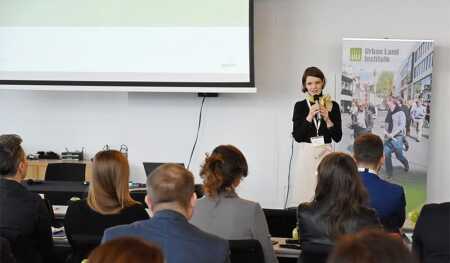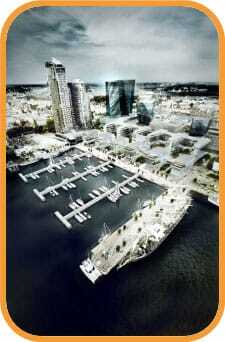Gdynia, a small port city on the Bay of Gdańsk in Poland, is looking to reinvent itself. Part of the tri-city metropolitan area, along with the cities of Gdańsk and Sopot, Gdynia boasts some of the happiest citizens in Poland; booming maritime, logistics, and transport sectors; distinctive modernist architecture; and a relatively low cost of living.
Despite these strengths, however, Gdynia is a shrinking city. According to the Central Statistical Office of Poland, the city’s population is projected to decline by more than 40,000 residents between now and 2050.
To attract more residents and stimulate its economy, Gdynia is embarking on a major urban regeneration project to create a new district: Sea City. Located on 71 hectares (175 ac) adjacent to the existing city center and with direct access to the Bay of Gdańsk, Sea City is envisioned as a rich, vital, and business-friendly district. With a mix of offices, retail, residential, and public spaces across the new district, Sea City has the potential to attract 8,000 residents and serve as a place of work for 4,000 additional people in the coming years, city planners estimate.
The development of Sea City does not come without challenges, however. While the city of Gdynia has planning powers and manages the space between buildings, private or state entities own and control the development of the vast majority of the land, making it difficult for the city to enact a cohesive vision for the district.
However, the city does control one key plot, which is located at the very end of the Molo Rybackie, a former fishing pier. The city envisions using the space for an iconic building that serves as an anchor for the new district. “We want the plot to be used in an attractive way. We want it to become the landmark of the city,” said Marek Karzynski, director of urban planning for Gdynia.
To help the city with its development strategy for the site, a panel of ULI members and urban experts convened in Gdynia in late February. Panelists included Chris Brown, director of marketing Liverpool, Liverpool Vision; Greg Clark, senior fellow, ULI Europe; Lisette van Doorn, CEO, ULI Europe; Nuala Gallagher, director of city center development, Belfast City Council; Angela Goodings, associate director of research, TH Real Estate; Daniela Matha, CEO, OPG Offenbacher; Tom Murphy, ULI senior fellow and former mayor of Pittsburgh; and Peter Zantopp-Goldmann, communications and marketing specialist, Zollhafen Mainz.
Over the course of the two-day workshop, the panelists spoke to over 50 developers, architects, potential investors, citizens, and city officials—including the mayor of Gdynia, Wojciech Szczurek, and the deputy mayor for economic issues, Katarzyna Gruszecka-Spychała—to discuss the redevelopment of the fishing pier site. These interviews with key stakeholders will help inform the panel’s recommendations for what should be built at the end of the fishing pier, how Gdynia can enhance Sea City’s vision and attractiveness as a place to live and visit, and what the city can do to help investors achieve their goals and align investors’ interests with the interests of Gdynia.
To enrich the debate and discussion around the fishing pier site, several panelists presented on their own experiences with waterfront redevelopment. In his keynote address, Murphy described the reinvention of the North Shore waterfront in Pittsburgh, an initiative he spearheaded as mayor. He highlighted the importance of strategic thinking, dynamic leadership, strong partnerships, talent, and placemaking in the reinvention of a city.
“People are comfortable with the status quo,” said Murphy. “The mayor and the developers need to decide that they’re not going to be satisfied with the status quo. This means looking around the world where cities have created wonderful spaces of vitality. I believe this conversation today is about two things: one is about creating a really great place to live, play, and work. On the other side of it is the opportunity of diversifying your economy. You have a port, potential for tourism, universities . . . how do you bring that together to redefine your city?”
Brown, Gallagher, Matha, and Zantopp-Goldmann also discussed lessons learned from the redevelopment of the waterfronts in Liverpool, Belfast, Offenbach, and Mainz, respectively.
According to Brown, leadership is crucial when undertaking a project like Sea City. “It’s about how you work to get the best results for your city, and the only way to do that is through leadership and the vision of the mayor bringing those people together,” he said.
Gallagher described how Belfast’s burgeoning film industry has helped the city flourish, and suggested that Gdynia may consider building film and animation studios to create jobs and generate more real estate demand.
During her presentation, Matha stressed the importance of showcasing the city’s strengths, a model that worked well in Offenbach: “It’s really important to show off what you have already in Gdynia: a film academy, arts collectors, great maritime history. You could easily pull all of those pieces together and put them into a vision for the future. This could be the first step to show the people where they come from, where they are, and where they want to go.”
Zantopp-Goldmann emphasized that successful waterfront developments, such as the Zollhafen district in Mainz, incorporate a mix of uses and are easily accessible to the public.
In addition to the case studies from waterfront cities, Goodings shared her expertise on investing in cities. For Gdynia to be attractive from an investor’s perspective, she said, the city should make its visibility in the wider tri-city agglomeration more apparent. Goodings also underscored the value of data: “Investors like data. They like the understanding and transparency of the data of how the city works now in order to understand where it can get to moving forward.”
A report on the panel’s recommendations for the redevelopment of the Gdynia fishing pier site will be published in the coming months.






